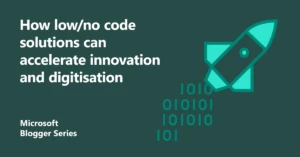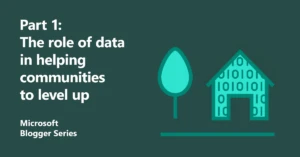
5 ways to modernise healthcare data and deliver better patient outcomes

We’re going to be sharing a story every week for the 12 weeks of summer, showing you how healthcare organisations are using technology to transform patient outcomes and increase productivity. For the eight blog in the series, Sarah Croxford looks at how data can improve patient care.
Imagine a data operating system that’s ready-made for the healthcare sector: a platform that reduces development times, frees up space for critical decision-making, and encourages organisations to maximise value from data.

In daily conversations with NHS FT leadership teams, I hear about their struggles to identify the right platforms, integrate methods that let them keep pace, and overcome changes in technical staff.
Vast chunks of time and money are wasted across the healthcare industry, with many making do with existing systems that aren’t fit for purpose, or attempting to create a bespoke data platform that meets every need – neither of which is desirable.
Often, trusts understandably decide the juice is not worth the squeeze, despite the impact a badly designed data management platform has on the experiences of both staff and patients.
Introducing Data Academy X-Series
A healthcare-orientated data operating system remedies this issue.
Insource has been working on the concept of the data operating system (DataOS) for many years to address the issues currently faced by healthcare chiefs, including the long-standing problem over how to introduce legacy data to a new platform – and to do so without any disruption to care-giving.
Now, leveraging the scaling capacity of the Azure platform and the Azure SQL Hyperscale capability, the Insource Data Academy Data Operating System (DataOS©) X-Series enables organisations to continually unlock value from their data, providing:
- Data infrastructure development
- Blueprinted enterprise data management architecture
- Development processes with a software configuration and release management application
“I was especially keen that our data warehouse tool was not a ‘black box’, and Data Academy certainly isn’t – its processes are transparent and it’s reassuring that nothing is hidden. We can always see what’s happened to our data at every step of the way.”
Julie Ryan, Head of Information and Analysis – Bolton CCG
How Data Academy X-Series works
1. Reduce the time to delivery of a healthcare-focused data platform
Data in a modern health setting must go further than reporting and business intelligence. As such, it needs to be delivered in a fashion upon which all of a trust’s downstream data-processing needs can be based.
This requires the development of an enterprise data-processing infrastructure that does it once, but for many uses. However, this is beyond the scope of most health providers. The only way for health organisations to enjoy a truly enterprise approach to data management is to reduce the cost of production.
One of DA-X’s main draws is its low-code/no-code development environment. No need to learn coding or similar technical skills; its pick-up-and-play nature means key functions such as Data Lineage, Audit and Error Trapping, Transformation Inheritance are available straight out of the box.
As a result, delivery times are slashed by up to 90%. That gives you more time to focus on giving care to those who need it most.
“Data Academy is quicker than writing solutions from the ground up. If we didn’t have Data Academy our team would need to be at least double in size as we would need more people across the technology spectrum to achieve what we are able to achieve with Data Academy. It is brilliant and the flexibility it affords is key to our success”
Steve Chokr, Former Deputy Chief Information Officer – Liverpool Women’s NHS Foundation Trust
2. Take away the guess work of delivering a successful enterprise data platform
A development environment alone can’t ensure successful delivery of a solution.
Let’s look to the construction industry to see how healthcare organisations can ensure successful delivery of developments. How is it that large warehouses, stores, and out-of-town shopping malls are built so quickly, and appear as robust as any bricks-and-mortar building?
The answer lies in pre-fabrication and blueprinted architectures. Thinking and planning are effectively taken out of constructing large floorplan buildings.
So it is with the data operating system that includes a pre-designed generic data management architecture.
In numerous healthcare deployments, this approach is proven to let trusts build their own data management platform. The upshot is, they can leapfrog the architectural design phase of the project, removing the guesswork from trust-based bespoke builds.
By effectively removing the technical decision-making from the development process, trusts enjoy significant savings.
“I’ve found that Data Academy reduces overall development time significantly – it takes away the need to develop many of the mundane elements of the job.”
Andrew Penny, Systems Architect – Heart of England NHS Foundation Trust (Now University Hospitals Birmingham NHS Foundation Trust)
3. Leverage value from the latest SQL Server releases
Healthcare trusts face a big decision when embarking on a data management strategy: which version of SQL Server should they base their delivery?
Fundamentally, upgrading between versions shouldn’t involve major work. Yet, once again, we see many examples where upgrades fail or cause major disruption. That’s something no trust can afford when committing to improving the patient experience.
The Data Academy X-Series removes this difficulty. As new versions of SQL Server are released, DA-X offers a seamless migration from previous to current versions. Data Academy, the predecessor to DA-X has been achieving this since SQL Server 2005.
In addition, the design means that when new SQL Server functionality is introduced, it’s built into the DA-X low-code/no-code language. Where functionality can be automatically implemented, it will do so. Developers don’t need to know how to program it, they just need to know how they want to use it. In this way DA-X cuts the implementation time for new SQL Server releases. This maximises the value trusts enjoy from new versions with the minimal requirement for change.
4. Move to Azure cloud deployment at the appropriate time
The greatest challenge for trusts is finding a compelling reason to move their on-premise deployments to the cloud. Financially, if a trust already has infrastructure and internal support, it’s difficult to justify the cost of migration.
Applications built in the DataOS DA-X can easily be migrated to the cloud. That means trusts have full control when moving to IaaS or PaaS, enabling them to commit long-term to the Microsoft platform in the knowledge that migration to Azure will be painless.
5. Enable the productisation of data solutions
Building a data infrastructure from the ground up, even with a data operating system behind you, is still a significant project. While the DataOS DA-X can reduce development times and costs, it’s a project that must not be undertaken lightly.
But as you prepare to create your bespoke applications, there’s another consideration to be had: the productisation of data solutions.
These are, at present, nearly non-existent, not just in health but across all industries. The lack of productised solutions stems from the inability of current technology to provide a platform on which IP-protected products can be licenced and developed for other health organisations
In response, DA-X is a platform that empowers users to build solutions they can release into the market. Such solutions can be installed with a single click, are IP-protected, and provided optionally with licencing. Providers can then be assured that their investment is protected.
If your IT team creates a truly stunning application that revolutionises how staff work, that’s something that ought to be shared with everybody – just like the NHS.
“Due to its clever technology, we were able to build modules and components ourselves when we thought they were needed and ship them back to Insource. Insource would then incorporate them into the actual product that would be released back to their user community, including us.”
Paul Johnson, Former Assistant Director of Information -South Warwickshire NHS Foundation Trust
About the author
 Sarah Croxford is Enterprise Channel Manager for Health Lead at Microsoft working within the One Commercial Partner group. Throughout her 20 years in the partner channel, 11 of those at Microsoft, she’s shown a passion for helping partners grow and succeed together with Microsoft. Sarah has extensive experience at leading blue chip companies including Microsoft, Siemens, TechData, and Ingram Micro. She’s led marketing, product marketing, and sales teams to build successful, reputable businesses, drive growth, and is well known for her channel knowledge. Her experience has won her recognition in the Women in Channel 2019 A-Listers, a finalist for the Women in Channel Sales Professional for 2018, Sales & Marketing finalist for the CRN awards, and finalist for the Real Faces of Sales for LinkedIn 2019. Sarah is also an Accessibility Advocate and a Board Director for Parenting Special Children, a charity that supports parents and children with special needs.
Sarah Croxford is Enterprise Channel Manager for Health Lead at Microsoft working within the One Commercial Partner group. Throughout her 20 years in the partner channel, 11 of those at Microsoft, she’s shown a passion for helping partners grow and succeed together with Microsoft. Sarah has extensive experience at leading blue chip companies including Microsoft, Siemens, TechData, and Ingram Micro. She’s led marketing, product marketing, and sales teams to build successful, reputable businesses, drive growth, and is well known for her channel knowledge. Her experience has won her recognition in the Women in Channel 2019 A-Listers, a finalist for the Women in Channel Sales Professional for 2018, Sales & Marketing finalist for the CRN awards, and finalist for the Real Faces of Sales for LinkedIn 2019. Sarah is also an Accessibility Advocate and a Board Director for Parenting Special Children, a charity that supports parents and children with special needs.




